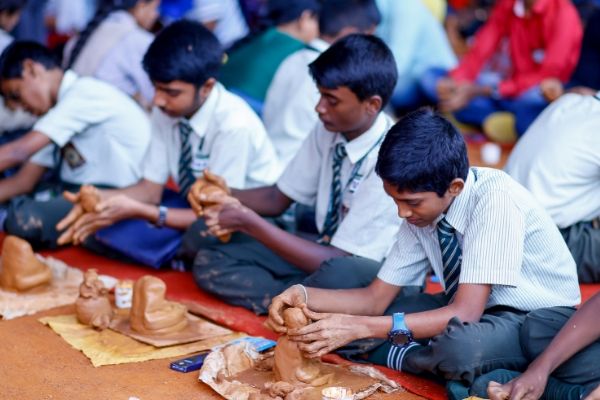Ganesh Chaturthi 2019: Let’s make it an eco-friendly celebration
According to the National Green Tribunal Act 2010 imposed by the Parliament, idol immersion is not allowed since they are made from non-biodegradable materials such plastic and Plaster of Paris (PoP). The use of heavy colours painted on lead and mercury are a big NO-NO. Instead, one can opt for environment–friendly hues.
With India celebrating Ganesh Chaturthi on September 2, it is important that the idols are not made from PoP. They would continue to float on water after immersion, thus adding unwanted waste to the environment. There are vast many options to make Ganesha idols with materials that the environment will love.
Ways of eco-friendly idol-making
At the 57th Bengaluru Ganesha Utsava, a seed clay-making event organised at National College grounds, Bengaluru on August 25 that saw some 2,300 odd people participating in the event in order to make eco-friendly idols for the upcoming festivities. Speaking to EducationWorld, Gopinath M., secretary of the event said, “Since, underground water is going low, the main motive of the event was to save water. We made Ganeshas using organic materials, clay and tusli seeds, which would not pollute the water. PoP Ganeshas pollute water but we wanted to save water and nature.
While making the clay Ganeshas, we put seeds inside them. After the Ganesha Puja is over, people can immersion them in the garden or place them in front of their home. Since their are seeds inside, if one waters them everyday, they will turn into plants. This way we can keep the environment green as well. The event also helped create awareness among everyone.”
For the event, 800 kg of natural materials were acquired from the Pottery Town in Bengaluru and the coffee land Chikkamagalur. The event also got hold of the Guinness World Records as it recorded the highest number of people gathered for clay model sculpting.

Other options:
In 2017, Nilesh Tupe, a Mumbaikar, urged the nation top go green and showed how to make Ganpati idols using cow dung. He especially sourced the cow dung for from gaushalas in Rajasthan. When made with co dung, the idols will cause no harm to floral and fauna. Rather, it would help produce oxygen and serves as a food for marine animals. Besides, it can be used to manure gardens and fields.
eCoexist, an organisation that believes in the “vision of an ecologically conscious society”. They started the campaign ‘Eco Ganesh’ under which they make idols using unbaked clay, cow dung and papier mache, all of which are bio-degradable.
If you think clay idols have become old-fashion, how about making idols with food stuffed in them? Mini statues made using turmeric and rice, chocolate, seeds are so in trend! Moreover, you can immerse the chocolate idols in milk and make chocolate milkshakes out of them later! You can distribute it among underprivileged children – now who wouldn’t love a choco-milkshake? Making idols using sugar is another option, which too can be immersed in milk.
This year, founder of Eco Eclectic Technologies, Binish Desai came with the idea of making Ganesha idols using jewellery. He used jewellery waste discarded by jewellery manufacturers and used a special binder to secure the waste and make idols out of it, which were painted using colours derived from flowers.
Decoration
- Use paper flowers in place of natural flowers.
- Use natural materials like cloth, wood and paper. You can make dolls, puppets, bells or origamis out of them to decorate around Ganpati idol.
- Use dried flowers to make natural colours to add to the decor.
Sukanya Nandy

















Add comment